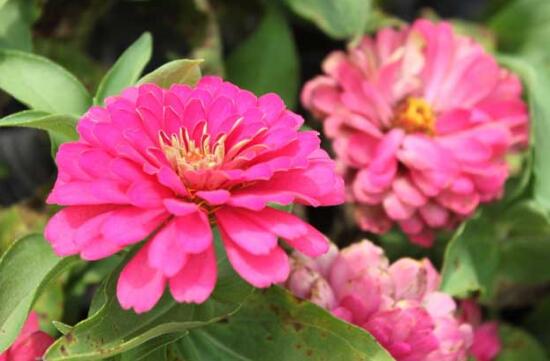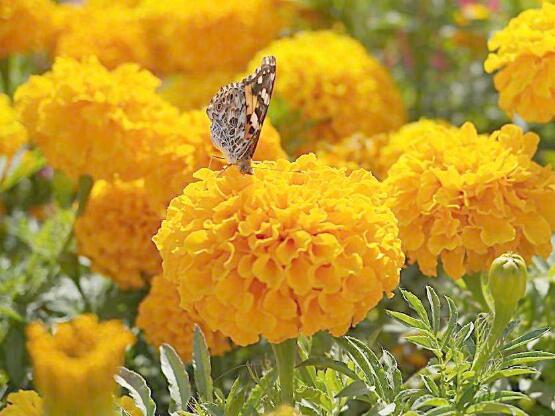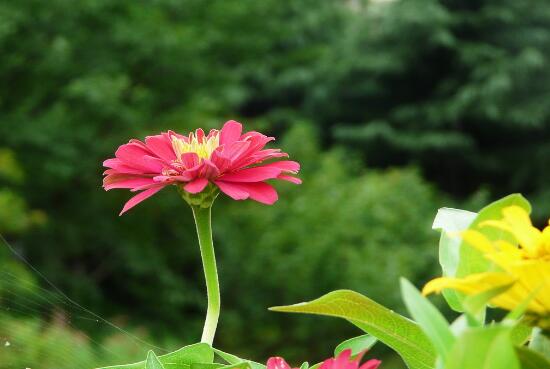Does the hundred-day grass need to pick the heart? the heart-picking method of the hundred-day grass / seize the opportunity to pick the heart twice
As a highly ornamental plant, zinnia not only grows fast, but also is easy to feed, so it is potted at home by many flower friends. However, it is precisely because the zinnia grows fast, so in order to avoid overgrowth, it is necessary to pick the heart in time. How to pick the heart? The following is the heart-picking method of zinnia, follow the editor to learn about it.
Does the hundred-day grass need to pick the heart? yes.

Zinnia, a kind of plant with strong vitality, grows very fast. if it is allowed to grow wantonly, it will destroy the overall plant type, uneven growth, and is not conducive to the uniform opening of flowers, thus affecting the ornamental nature. so does zinnia need to pick the heart? the answer is yes.
The main reason is to control the plant height, which can save a lot of nutrients and achieve the effect of dwarfing plants. In addition, picking the heart can also promote the germination of lateral branches. the more lateral branches germinate, the more buds and flowers naturally bloom. So picking the heart is very necessary for raising hundred-day grass.
2. The method of picking the heart of zinnia.
1. Time to pick out the heart
The most important thing is to take the right way to pick the heart, but in addition, it is very important to grasp the timing, because if the timing is not good, it may cause irreparable losses:
Heart picking too early: because the plant is too young and weak, it may inhibit the normal growth of the plant, and if it is picked at the seedling stage, it may even lead to the risk of plant death.
If the heart is picked too late, the plant may have grown too tall to achieve the effect of dwarfing, and the lateral branches germinate slowly or even not, and of course the flowers will decrease.
Heart-picking time: when the seedlings of zinnia grow into 4 leaves, we can plant them and pick them out after 7 days. Picking the heart at the right time can make the hundred-day grass blossom with more beautiful flowers.
2. Pick the heart for the first time
When the seedlings of zinnia grow to 4 leaves, they should be planted and heart-picked. After 7 days of planting, we can carry out the first heart-picking: when the seedling height of the hundred-day grass is about 10cm, leave two pairs of leaves and the rest of the leaves for heart-picking. After removing the heart, you can spray a fungicide, and then apply a thin fertilizer.
3. Pick the heart for the second time
It is not that we don't pick the heart after one pick, when the zinnia grows 2-3 pairs of leaves, we need to pick the heart for the second time, which not only makes the column "fat", but also allows the plant to increase the number of flowers.
Methods: the solution was sprayed evenly on the upper leaves of the plant, once every one to two weeks, for a total of 2 or 3 times.
Note: the number of heart-picking can not be carried out as soon as you want, according to the growth of the plant and the branching situation to decide whether to carry out the next heart-picking.
With regard to the heart-picking method of potted hundred-day grass, the editor has introduced it here, hoping to bring help to everyone. Generally speaking, zinnia is very ornamental after flowering. In order for the plant to produce more and more beautiful flowers, we must pick its heart. Because the zinnia has strong vitality, even if it is a novice, you can pick the heart as long as you pay attention to it.
How to control the black spot of Zinnia tomentosa
Hundred-day grass generally refers to hundred-day chrysanthemum.
Zinzhiju (scientific name: Zinnia elegans Jacq.): annual herb. Stem erect, 30-100 cm tall, hispid or hirsute. Leaves broadly ovoid or oblong-elliptic, both surfaces scabrous, densely hispid below, basally triveined. Capitate inflorescences solitary branch ends, involucral bracts broadly campanulate; involucral bracts multilayered, broadly ovate or ovate-elliptic. Ligulate flowers crimson, rose, pansy or white, tongue Obovate, apex 2-3-toothed or entire, pubescent above and villous below. Tubular flowers yellow or orange, apex lobes ovate-lanceolate, covered with yellowish brown dense hairs. Female flowers: achenes Obovate-orbicular, tubular flowers: achenes Obovate-cuneate. The florescence is from June to September and the fruiting period is from July to October.
How to control the black spot of Zinnia tomentosa
Black spot is a stubborn disease, its leaves, stems and flowers can all be harmed. At the beginning of the disease, the leaves were small black-brown spots, and soon expanded into irregular spots, with a diameter of 0.2 cm to 1 cm, and the center became grayish-white necrosis. but the color is the same in the center and edge of the disease spot on the back of the leaf. With the increase of spots, the whole leaf became brown and withered. The disease on the stem starts from the petiole and develops longitudinally into strips of black and brown spots. When it is wet, a black powdery mildew layer appears in the disease. When the stem base is damaged in the seedling stage, the ulcer spot with sunken center from dark brown to dark brown is formed, and when it is serious, it can be cut across the base, causing the stem to wither. According to these characteristics, we can accurately judge whether the plant is infected with black spot or not. It overwintered with hyphae on the damaged stems and leaves, and the diseased seeds were also the source of primary infection; in the following spring, the conidia spread by wind and rain and invaded from the wound or stomata, the disease was serious in the high temperature season, and the plant was too dense from August to September. Poor ventilation and light transmission, excessive application of nitrogen fertilizer, are easy to cause the disease. The time and method of prevention and control are not suitable, which can prevent the occurrence and spread of the disease. We should remove the susceptible stems, leaves and flower remains in time and burn them centrally, which can not be ignored. It is important that full seeds should be harvested on healthy and disease-free plants. The uninfected plant growing on the edge of the flower bed may be formed from the germination of seeds without pathogens, or it may be a relatively disease-resistant single plant, so you might as well leave it for a try. Once a small number of disease spots are found on the plant, the diseased leaves should be cut off and burned quickly, and all plants should be sprayed with 50% mancozeb and mancozeb wettable powder 500 times in time, every 10 days, 3 to 4 times in a row. When spraying, special attention should be paid to spraying both the front and back of the leaves evenly. Attention should be paid to the preparation of potted soil. the perennial soil planted in potted zinnia can no longer be used in the second year, and it is required to be mixed with loose and fertile sandy soil with good drainage and rich in humus and organic fertilizer. In the process of cultivation, ventilation and light transmission should be strengthened, the amount of nitrogen fertilizer should be controlled, and attention should be paid to the balanced supply of nitrogen, phosphorus and potassium. Spring is coming, what's the idea of growing flowers at home?
When the cold winter is gone, everything recovers in spring, and it's time to move the seedlings out of the house to see the sun, but as it is the transition between winter and spring, the weather is easy to change, so we need to pay attention to the change of good weather. There are still a lot of things to pay attention to to protect your flowers.
1. To breed.
Spring is a good time for sowing, cutting and grafting. Annual herbaceous flowers sowing, such as impatiens, cockscomb, zinnia, a bunch of red, etc., should prepare seeds and containers, soil, etc., in accordance with the temperature requirements of seed germination, sowing at the right time, do not miss the opportunity. And according to the seed particle size, take different sowing and water supply methods, covered with glass or plastic film, maintain a certain temperature and humidity to make it germinate as soon as possible. Spring is also a good time for cutting propagation of many flowers. The branches pruned in spring can be selected, and the sturdy ones will be used as cuttings and inserted at the edge of the basin. After careful management, the survival rate is higher. Woody flowers are often propagated by cutting and splitting in spring. Rootstocks should be prepared in time, scions should be selected and grafting should be carried out at the right time. Conscientiously and carefully do a good job in the management after grafting to ensure the survival rate of seedlings as far as possible.
two。 Come out of the room in due course.
China has a vast territory and different climatic conditions, so the time of potted flowers coming out of the room is different. Experienced flower growers have summed up two experiences in their long-term flower cultivation practice: one is called "spring does not come out", and the other is called "winter does not enter". "Spring doesn't come out", that is, don't rush to let flowers out of the house in early spring. Because the northern spring temperature is changeable, the wind is strong, there is often a cold snap, such as leaving the room too early is easy to be harmed by the cold wind, buds and leaves are often scorched, or cause a large number of fallen leaves, which will cause the death of the whole plant in serious cases, so it is not advisable to leave the room too early. The suitable time for indoor overwintering flowers in most areas of the north is between Qingming Festival and the Beginning of Summer. Flowers need to go through a period of exercise to adapt to the environment before going out of the room, that is, opening windows and ventilation around noon to make them gradually adapt to the external temperature and then go out of the room. Put it in a leeward and sunny place when you get out of the room. In case of windy weather or late frost, it is still necessary to move people indoors in time and move out when the weather improves.
3. Change the basin and soil in time.
Potted flowers have limited growth in the flowerpots. After one or two years of growth and development and budding and flowering, the nutrients of the potted soil are almost consumed. Therefore, it is necessary to change the basin and change the soil, increase the soil nutrients and improve the soil permeability. When changing pots, perennial roots and woody flowers should be in dormant period and before new buds sprout in early spring; those flowering in early spring should change pots after flowering, such as potted plum blossoms, peach blossoms, primrose, longevity flowers, gentleman orchids, crab claw orchids and so on. The sandy loam which is rich in humus, fertile and with good drainage and air permeability is mostly used to change the basin. Some flowers can split when changing pots, such as orchids, orchids, etc.
4. Gradually increase the fat and water.
Spring is the season for the growth and development of all kinds of flowers. Insufficient supply of water and fertilizer will often lead to the withering or even death of flowers. Should pay attention to spray water on the leaf surface, keep moist, watering to the right amount, see wet see dry. Fertilization should be timely according to different kinds of fertilizer. Such as gentleman orchid, canna, Milan, jasmine, etc., should be applied liquid fertilizer every ten days.
5. Reasonable pruning.
Spring is the best season for flower pruning. Some woody flowers, such as crape myrtle and rose, prune branches properly in accordance with their respective requirements in order to promote new branches when the sap has not yet flowed in early spring. Plum blossom, green peach and so on are pruned after blossom, generally leaving only two or three bud eyes at the base, and the rest are cut off. When the new tip grows to 10 to 15 centimeters, pick the heart. If it is repeated two or three times, more flower branches can be formed. The old branches of poinsettia should be pruned in early spring, leaving only two or three buds in the lower part of each branch, and all the upper branches should be cut off to promote the germination of new branches.
The above is for the flower friends to explain the spring family flower cultivation points for attention, I hope to bring help to you. You are also welcome to continue to pay attention to the succulent flower bed, we will continue to update the knowledge of flower culture for you!
- Prev

How to water marigold, watering methods and precautions / avoid stagnant water
Marigold is a kind of highly ornamental plant, there are many places that need to be paid attention to in the process of marigold culture, among which water is indispensable. How to water marigold? What are the watering methods and points for attention of marigold? Next, the editor will take you to learn about it.
- Next

How to water the zinnia? when will the zinnia be watered / the stronger the light, the more it will be watered?
Speaking of zinnia, many people should have heard of it. Although it is grass, it can produce extremely beautiful and bright flowers, and because it is easy to raise, more and more people begin to plant it at home. But in the process of breeding, many flower lovers will encounter problems when watering. They don't know how to water zinnia.
Related
- Fuxing push coffee new agricultural production and marketing class: lack of small-scale processing plants
- Jujube rice field leisure farm deep ploughing Yilan for five years to create a space for organic food and play
- Nongyu Farm-A trial of organic papaya for brave women with advanced technology
- Four points for attention in the prevention and control of diseases and insect pests of edible fungi
- How to add nutrient solution to Edible Fungi
- Is there any good way to control edible fungus mites?
- Open Inoculation Technology of Edible Fungi
- Is there any clever way to use fertilizer for edible fungus in winter?
- What agents are used to kill the pathogens of edible fungi in the mushroom shed?
- Rapid drying of Edible Fungi

